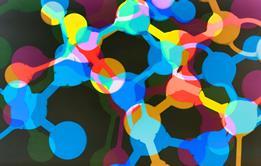The humble lines that link atoms and connote chemical connections in molecular structures are the simplest of chemistry’s iconography. Yet those seemingly simple sticks belie our most complex and clouded concept: the chemical bond.
Bonds are chemistry’s key intellectual property, but they are also a somewhat illusory idea. The chemical bond is a contingent and approximate concept, a chimeric heuristic that is moulded and adapted according to our need. Indeed, chemists still argue about what constitutes a bond, how it should be defined and whether they even really exist. Although if bonds are purely an invention, then it is one so supremely useful and utterly seductive that it is chemistry’s greatest work of fiction. In our bonding collection, we’re celebrating the bond in all its fuzzy incarnations.
We might be approaching the point when the ‘inadequate mental abstractions’ of the past start to hold us back
Despite a century of development in our increasingly sophisticated understanding of bonding, most chemists are content not to examine them too closely. The system first proposed by Gilbert Lewis in 1916 still endures as the cornerstone of chemistry education and practice – and not because it is the most ‘correct’, but because it is so accessible and useful. Lewis’s genius was intuiting his theory of electron pairing and sharing from observations made by other chemists and physicists regarding the structure of the atom, periodicity, and the properties and compositions of materials. When quantum physics came along a few years later, it promised to place bonding on a fundamental footing, and molecular orbital theory arguably could have superseded the Lewis model. Thanks largely to Linus Pauling’s valence bond theory, the Lewis model was instead adapted and incorporated, establishing its place as an ever-evolving idea.
More surprising than the Lewis model’s longevity, however, is that the phenomena it sought to explain are still being discussed and debated. What is a bond? What is going on in a bond? How and why do bonds form? We know that in covalent bond formation electron density accumulates between the nuclei and energy is lowered, for example, but whether the basis for that energy lowering effect is electrostatic or quantum mechanical is still debated. In this collection, Alistair Sterling and Martin Head-Gordon propose a theory that unifies the two sides of that debate. And Vanessa Seifert takes a nuanced look at how the way we think about bonds has helped chemistry progress.
Elsewhere in this issue, we look at the various ways bonds and bonding are still being explored and discovered. Mechanical bonds have gone from being a thought experiment to a new and entirely different type of connection that is essentially orthogonal to the outcomes of the Schrödinger equation. In the process, chemists have become expert at manipulating the delicate weak and non-bonding interactions that coax atoms into these unfamiliar arrangements. A veritable zoo of such weak bonds now exist for chemists to deploy in designing systems and engineering dynamic interactions. Finally, we look at the extremes of the chemical bonding spectrum and how the nature of the chemical bond changes as it is pushed into new realms by pressure and temperature.
Much has changed in the century since the Lewis model was proposed. In particular, the growth in computing power and computational techniques have overcome quantum chemistry’s intital shortcoming of being too mathematically complicated to be of much use. Today, we have access to simulations at timescales and spatial scales relevant to understanding chemical phenomena. And the prospect of fully quantum calculations with quantum computers is on the horizon. As our understanding continues to develop we might approach the point when, in Lewis’s words, the ‘inadequate mental abstractions’ of the past start to hold us back. If that time is near, then bonds may yet come to divide us.

Bonds are the ties that bind chemistry

Those seemingly simple sticks belie our most complex concept




























No comments yet